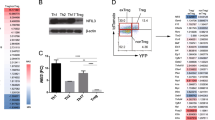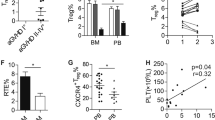Abstract
Exact mechanism of action of umbilical cord blood (CB)-derived regulatory T cells (Tregs) in the prevention of GVHD remains unclear. On the basis of selective overexpression of peptidase inhibitor 16 in CB Tregs, we explored the related p53 pathway, which has been shown to negatively regulate miR15a/16 expression. Significantly lower levels of miR15a/16 were observed in CB Tregs when compared with conventional CB T cells (Tcons). In a xenogeneic GVHD mouse model, lower levels of miR15a/16 were also found in Treg recipients, which correlated with a better GVHD score. Forced overexpression of miR15a/16 in CB Tregs led to inhibition of FOXP3 and CTLA4 expression and partial reversal of Treg-mediated suppression in an allogeneic mixed lymphocyte reaction that correlated with the reversal of FOXP3 demethylation in CB Tregs. On the other hand, miR15a/16 knockdown in CB Tcons led to expression of FOXP3 and CTLA4 and suppression of allogeneic lymphocyte proliferation. Using a luciferase-based mutagenesis assay, FOXP3 was determined to be a direct target of miR15a and miR16. We propose that miR15a/16 has an important role in mediating the suppressive function of CB Tregs and these microRNAs may have a ‘toggle-switch’ function in Treg/Tcon plasticity.
This is a preview of subscription content, access via your institution
Access options
Subscribe to this journal
Receive 12 print issues and online access
$259.00 per year
only $21.58 per issue
Buy this article
- Purchase on Springer Link
- Instant access to full article PDF
Prices may be subject to local taxes which are calculated during checkout



Similar content being viewed by others
References
Sakaguchi S . Regulatory T cells: history and perspective. Methods Mol Biol 2011; 707: 3–17.
Brunstein CG, Miller JS, Cao Q, McKenna DH, Hippen KL, Curtsinger J et al. Infusion of ex vivo expanded T regulatory cells in adults transplanted with umbilical cord blood: safety profile and detection kinetics. Blood 2011; 117: 1061–1070.
Di Ianni M, Falzetti F, Carotti A, Terenzi A, Castellino F, Bonifacio E et al. Tregs prevent GVHD and promote immune reconstitution in HLA-haploidentical transplantation. Blood 2011; 117: 3921–3928.
Taylor PA, Lees CJ, Blazar BR . The infusion of ex vivo activated and expanded CD4(+)CD25(+) immune regulatory cells inhibits graft-versus-host disease lethality. Blood 2002; 99: 3493–3499.
Edinger M, Hoffmann P, Ermann J, Drago K, Fathman CG, Strober S et al. CD4+CD25+ regulatory T cells preserve graft-versus-tumor activity while inhibiting graft-versus-host disease after bone marrow transplantation. Nat Med 2003; 9: 1144–1150.
Hippen KL, Harker-Murray P, Porter SB, Merkel SC, Londer A, Taylor DK et al. Umbilical cord blood regulatory T-cell expansion and functional effects of tumor necrosis factor receptor family members OX40 and 4-1BB expressed on artificial antigen-presenting cells. Blood 2008; 112: 2847–2857.
Hori S, Nomura T, Sakaguchi S . Control of regulatory T cell development by the transcription factor Foxp3. Science 2003; 299: 1057–1061.
Fontenot JD, Gavin MA, Rudensky AY . Foxp3 programs the development and function of CD4+CD25+ regulatory T cells. Nat Immunol 2003; 4: 330–336.
Zheng Y, Josefowicz SZ, Kas A, Chu TT, Gavin MA, Rudensky AY . Genome-wide analysis of Foxp3 target genes in developing and mature regulatory T cells. Nature 2007; 445: 936–940.
Liston A, Lu LF, O'Carroll D, Tarakhovsky A, Rudensky AY . Dicer-dependent microRNA pathway safeguards regulatory T cell function. J Exp Med 2008; 205: 1993–2004.
Zhou X, Jeker LT, Fife BT, Zhu S, Anderson MS, McManus MT et al. Selective miRNA disruption in T reg cells leads to uncontrolled autoimmunity. J Exp Med 2008; 205: 1983–1991.
Ranganathan P, Heaphy CE, Costinean S, Stauffer N, Na C, Hamadani M et al. Regulation of acute graft-versus-host disease by microRNA-155. Blood 2012; 119: 4786–4797.
Rouas R, Fayyad-Kazan H, El Zein N, Lewalle P, Rothe F, Simion A et al. Human natural Treg microRNA signature: role of microRNA-31 and microRNA-21 in FOXP3 expression. Eur J Immunol 2009; 39: 1608–1618.
Lu LF, Thai TH, Calado DP, Chaudhry A, Kubo M, Tanaka K et al. Foxp3-dependent microRNA155 confers competitive fitness to regulatory T cells by targeting SOCS1 protein. Immunity 2009; 30: 80–91.
Sadlon TJ, Wilkinson BG, Pederson S, Brown CY, Bresatz S, Gargett T et al. Genome-wide identification of human FOXP3 target genes in natural regulatory T cells. J Immunol 2010; 185: 1071–1081.
Nicholson IC, Mavrangelos C, Bird DR, Bresatz-Atkins S, Eastaff-Leung NG, Grose RH et al. PI16 is expressed by a subset of human memory Treg with enhanced migration to CCL17 and CCL20. Cell Immunol 2012; 275: 12–18.
Parmar S, Robinson SN, Komanduri K St, John L, Decker W, Xing D et al. Ex vivo expanded umbilical cord blood T cells maintain naive phenotype and TCR diversity. Cytotherapy 2006; 8: 149–157.
Parmar SLS, Tung SS, Robinson SN, Rodriguez G, Cooper LJN, Yang H et al. Third-party umbilical cord blood–derived regulatory T cells prevent xenogenic graft-versus-host disease. Cytotherapy 2013; 16: 90–100.
Sato T, Deiwick A, Raddatz G, Koyama K, Schlitt HJ . Interactions of allogeneic human mononuclear cells in the two-way mixed leucocyte culture (MLC): influence of cell numbers, subpopulations and cyclosporin. Clin Exp Immunol 1999; 115: 301–308.
Reddy V, Hill GR, Pan L, Gerbitz A, Teshima T, Brinson Y et al. G-CSF modulates cytokine profile of dendritic cells and decreases acute graft-versus-host disease through effects on the donor rather than the recipient. Transplantation 2000; 69: 691–693.
Schmittgen TD, Livak KJ . Analyzing real-time PCR data by the comparative C(T) method. Nat Protoc 2008; 3: 1101–1108.
Diegelmann J, Olszak T, Goke B, Blumberg RS, Brand S . A novel role for interleukin-27 (IL-27) as mediator of intestinal epithelial barrier protection mediated via differential signal transducer and activator of transcription (STAT) protein signaling and induction of antibacterial and anti-inflammatory proteins. J Biol Chem 2012; 287: 286–298.
Bonci D, Coppola V, Musumeci M, Addario A, Giuffrida R, Memeo L et al. The miR-15a-miR-16-1 cluster controls prostate cancer by targeting multiple oncogenic activities. Nat Med 2008; 14: 1271–1277.
Fabbri M, Bottoni A, Shimizu M, Spizzo R, Nicoloso MS, Rossi S et al. Association of a microRNA/TP53 feedback circuitry with pathogenesis and outcome of B-cell chronic lymphocytic leukemia. JAMA 2011; 305: 59–67.
Lewis BP, Shih IH, Jones-Rhoades MW, Bartel DP, Burge CB . Prediction of mammalian microRNA targets. Cell 2003; 115: 787–798.
Betel D, Wilson M, Gabow A, Marks DS, Sander C . The microRNA.org resource: targets and expression. Nucleic Acids Res 2008; 36: D149–D153.
Gibbs GM, Roelants K, O'Bryan MK . The CAP superfamily: cysteine-rich secretory proteins, antigen 5, and pathogenesis-related 1 proteins—roles in reproduction, cancer, and immune defense. Endocr Rev 2008; 29: 865–897.
Diez-Roux G, Banfi S, Sultan M, Geffers L, Anand S, Rozado D et al. A high-resolution anatomical atlas of the transcriptome in the mouse embryo. PLoS Biol 2011; 9: e1000582.
Ye J, Huang X, Hsueh EC, Zhang Q, Ma C, Zhang Y et al. Human regulatory T cells induce T-lymphocyte senescence. Blood 2012; 120: 2021–2031.
Sawant DV, Wu H, Kaplan MH, Dent AL . The Bcl6 target gene microRNA-21 promotes Th2 differentiation by a T cell intrinsic pathway. Mol Immunol 2013; 54: 435–442.
Baron U, Floess S, Wieczorek G, Baumann K, Grutzkau A, Dong J et al. DNA demethylation in the human FOXP3 locus discriminates regulatory T cells from activated FOXP3(+) conventional T cells. Eur J Immunol 2007; 37: 2378–2389.
Balaguer F, Link A, Lozano JJ, Cuatrecasas M, Nagasaka T, Boland CR et al. Epigenetic silencing of miR-137 is an early event in colorectal carcinogenesis. Cancer Res 2010; 70: 6609–6618.
Fabbri M, Garzon R, Cimmino A, Liu Z, Zanesi N, Callegari E et al. MicroRNA-29 family reverts aberrant methylation in lung cancer by targeting DNA methyltransferases 3A and 3B. Proc Natl Acad Sci USA 2007; 104: 15805–15810.
Klein ME, Lioy DT, Ma L, Impey S, Mandel G, Goodman RH . Homeostatic regulation of MeCP2 expression by a CREB-induced microRNA. Nat Neurosci 2007; 10: 1513–1514.
Varambally S, Cao Q, Mani RS, Shankar S, Wang X, Ateeq B et al. Genomic loss of microRNA-101 leads to overexpression of histone methyltransferase EZH2 in cancer. Science 2008; 322: 1695–1699.
Bachmann MF, Kohler G, Ecabert B, Mak TW, Kopf M . Cutting edge: lymphoproliferative disease in the absence of CTLA-4 is not T cell autonomous. J Immunol 1999; 163: 1128–1131.
Josefowicz SZ, Lu LF, Rudensky AY . Regulatory T cells: mechanisms of differentiation and function. Annu Rev Immunol 2012; 30: 531–564.
Zheng SG, Wang JH, Stohl W, Kim KS, Gray JD, Horwitz DA . TGF-beta requires CTLA-4 early after T cell activation to induce FoxP3 and generate adaptive CD4+CD25+ regulatory cells. J Immunol 2006; 176: 3321–3329.
Acknowledgements
The funding for this work was provided by institutional funds
Author information
Authors and Affiliations
Corresponding author
Ethics declarations
Competing interests
The authors declare no conflict of interest.
Additional information
Supplementary Information accompanies this paper on Bone Marrow Transplantation website
Rights and permissions
About this article
Cite this article
Liu, X., Robinson, S., Setoyama, T. et al. FOXP3 is a direct target of miR15a/16 in umbilical cord blood regulatory T cells. Bone Marrow Transplant 49, 793–799 (2014). https://doi.org/10.1038/bmt.2014.57
Received:
Revised:
Accepted:
Published:
Issue Date:
DOI: https://doi.org/10.1038/bmt.2014.57
This article is cited by
-
Treg plasticity and human diseases
Inflammation Research (2023)
-
miRNA Regulation of T Cells in Islet Autoimmunity and Type 1 Diabetes
Current Diabetes Reports (2020)
-
Autologous hematopoietic SCT normalizes miR-16, -155 and -142-3p expression in multiple sclerosis patients
Bone Marrow Transplantation (2015)
-
MicroRNAs as biomarkers for graft-versus-host disease following allogeneic stem cell transplantation
Annals of Hematology (2015)



